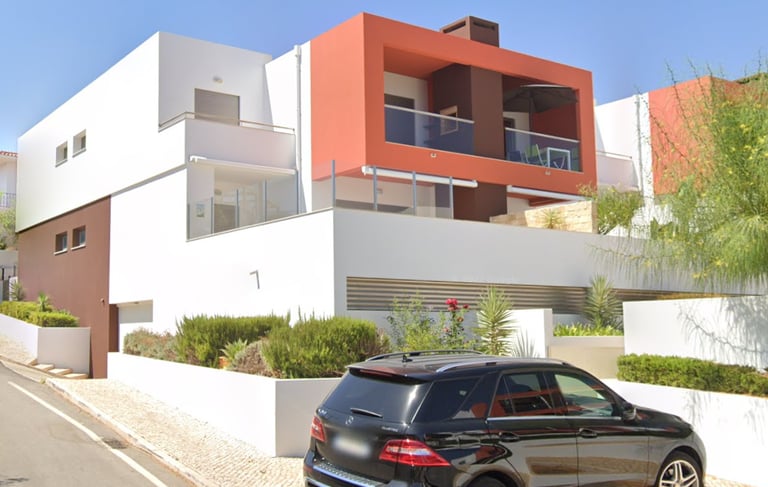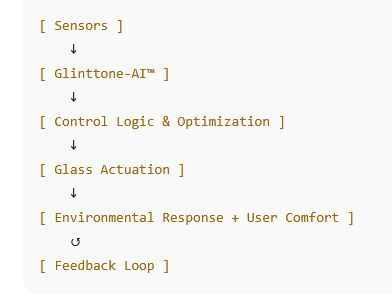Defensive Disclosure Publication Outline: Glinttone™ / Glinttone™ I
The Future Has Arrived
Title: Artificial Intelligence-Controlled Climate-Adaptive Smart Glazing System
The Warming
Europe is warming at nearly twice the global average rate, bringing record-breaking summer temperatures and dangerous heatwaves that pose an escalating threat to public health (WHO 2025, EEA 2024). Between 60,000 and 70,000 heat-related deaths occurred in 2022, with nearly 48,000 more in 2023. Vulnerable groups—including the elderly, children, low-income households, and people with health conditions—are most at risk.
In response, many European households rely on manual roll‑down shutters to block solar heat. While effective at reducing indoor temperatures—sometimes by up to 2 °C—and lowering air-conditioning needs by up to 60%, these shutters also block daylight, transform homes into dim, enclosed spaces, and are not always feasible for retrofitting legacy or heritage buildings.
Meanwhile, extreme heat doesn’t just harm physical health—it degrades mental health, cognitive functioning, and mood. Research links rising temperatures to increased aggression, depression, anxiety disorders, and even suicide risk. For every 1 °C increase in monthly average temperature, mental health-related mortality rises by 2.2%, and cognitive performance suffers.
Sources: WHO, EEA, Climate-ADAPT. The Times, LeMonde.fr, World Economic Forum, and NCBI.


INTRODUCTION
Glinttone™: Background Statement
Europe’s buildings are among the least energy-efficient in the developed world, with an estimated 75% in need of renovation—largely due to outdated windows that neither insulate well nor adapt to seasonal extremes (Research and innovation). In summer, residents commonly lower opaque shutters to block heat—but at the cost of plunging interiors into darkness, disrupting comfort, visual connection, and well-being. In winter, those same windows fail to retain warmth, forcing reliance on energy-intensive heating.
Enter Glinttone™, a leap beyond traditional “smart glass.” Unlike passive thermochromic or single-mode electrochromic systems, Glinttone™ is an AI-integrated, climate‑adaptive smart glazing solution—the next generation of climate-adaptive building shell (CABS) technology—that dynamically responds to both light and heat while intentionally preserving natural daylight and occupants’ comfort


Improves energy efficiency and reduces energy cost.
Adapts intelligently, using local weather history and real-time sensor data to preemptively modulate light and thermal properties based on seasonal and situational trends.
★★★★★
★★★★★
In doing so, Glinttone™ provides more than mere shading—it restores comfort, enhances mood, and lowers energy use, without the psychological toll of living in the absence of natural lighting.
Summary of Innovation
Glinttone™: Re-Imagining Light and Climate with Intelligence
Reflects infrared heat in summer, and absorbs warmth in winter, cutting HVAC dependencies.
Reduces glare and heat, while preserving daylight and connection with the outside.
★★★★★
★★★★★
Glinttone™ delivers a humane, energy-smart alternative. It’s a climate-aware, AI-integrated smart glazing system that:
System Components
1. Smart Glass Assembly (Hardware Layer)
These are the physical layers embedded in the glass unit:
◼️ Multilayer Electrochromic or Suspended Particle Device (SPD) Film
Controls visible light and infrared transmission
Modulates transparency and heat filtering
Uses liquid crystal, tunable nanoparticles, or SPD particles
◼️ Photothermal or Thermochromic Coating
Reflects heat in summer, absorbs in winter
Responds to solar radiation or external heat stimuli
May use VO₂ (vanadium dioxide) or organic thin films.
◼️ Transparent Conductive Electrodes
ITO (Indium Tin Oxide) or graphene-based
Apply voltage across the glazing layers for activation
◼️ Sensor Suite (embedded or external)
Measures ambient light, UV index, temperature, humidity, and thermal gain/loss
Optionally includes occupancy or daylight availability sensors service.
2. Glinttone-AI™ Intelligence Layer (Software/Cloud)
This is the brains of the system—where adaptation happens:
◼️ Predictive Climate Engine
Uses historic weather data + real-time local forecasts
Adjusts glazing state proactively based on seasonal models
Learns from daily usage and light preferences over time
◼️ Thermal Load Optimization Algorithm
Calculates solar gain/loss
Minimizes HVAC demand by fine-tuning transparency and reflectivity
◼️ Circadian Rhythm-Aware Mode (optional)
Tunes light levels for human biological cycles
Supports productivity, sleep, and mood regulation
◼️ Integration API
Connects with smart home ecosystems, building automation systems (BAS), or automotive platforms
Compatible with Matter, Zigbee, KNX, etc.
3. Control & Power Infrastructure
◼️ Low-Voltage Driver & Power Supply
Converts power to appropriate voltage for glass modulation (typically 5–12V)
Includes safety and surge protection
◼️ Edge Controller / Hub
On-site processor that relays sensor input to the AI system
Handles offline fallback modes, manual override, and security
◼️ Mobile or Wall Interface
Glinttone™ app or touch panel interface
Allows users to manually adjust tint or switch to preset modes (e.g., "Summer Shield," "Daylight Boost")
4. Control & Power Infrastructure
Optional System Enhancements
Battery/solar backup for grid independence or vehicles
Automated glazing zones for selective modulation (e.g., only upper window portion dims)
Interior light harmonization (connects with indoor lighting systems for seamless brightness transitions)
Key Functional Flow
2. AI-Driven Climate Profiling
Glinttone-AI™ references:
Historical weather patterns (for that exact location)
Real-time local weather forecasts (via web APIs)
User comfort preferences (stored in system memory)
Building envelope characteristics (e.g. window orientation, HVAC behavior)
👉 This creates a thermal and lighting “profile” based on predictive analytics.
1. Environmental Sensing
Sensors (internal & external) measure:
Ambient temperature
Sun position & solar radiation
Light intensity (lux, UV, IR)
Humidity and indoor climate
Optional: occupancy, time of day, season
👉 Raw input data is continuously collected from the environment and the building interior.
★★★★★
★★★★★
The key functional flow of the Glinttone™ system outlines how environmental data is sensed, processed, and translated into intelligent glass modulation—balancing light, heat, and comfort. Here's a rough flowchart and clear step-by-step breakdown:


Optional Events Triggers:
Emergency override (e.g., glare spike, fire, blackout)
Scheduled modes (e.g., “Morning Boost” or “Sleep Mode”)
Smart home/vehicle integration (e.g., “Away” mode dims glass fully)
5. Feedback Loop & Adaptation
System monitors:
Actual change in indoor light and temperature
Whether goals (e.g., comfort, energy targets) were met
Adjusts in real time as conditions evolve (e.g., clouds move, room heats up)
👉 The system learns from user behavior and environmental patterns over time, continuously refining performance.
★★★★★
★★★★★
4. Signal Transmission to Glazing
A low-voltage command is sent to:
Electrochromic / SPD / liquid crystal layers
Photothermal or thermochromic coatings (if applicable)
Voltage or heat alters glass properties:
Tint darkens/lightens
Infrared reflectivity changes
Visible light transmission is modulated
👉 Glass responds physically—without mechanical shades or blinds.
3. Decision-Making & Control Logic
The system determines:
How much tint, reflectivity, or transparency is needed
Whether to retain heat (winter) or block heat (summer)
If glare needs to be reduced for occupant comfort
Algorithm weighs factors like:
Circadian timing (e.g., morning light vs. evening dimness)
Energy use optimization (balance HVAC load vs. daylighting)
User preferences or manual override states
👉 An optimal glass state is selected per window zone in real time.
★★★★★
★★★★★
Automatic Control
Manual Control
Glinttone™ delivers more than thermal comfort and energy savings—it restores daylight, well-being, and awareness in homes that have long shut themselves off from the world to stay cool.






How Glinttone™ Stands Apart
Examples of Use Cases
“Glinttone™ lets users simulate the sensation of any world climate—from Nordic daylight to tropical warmth—through intelligent glass modulation. It’s not just window tinting; it’s environmental storytelling.
Residential Architecture
Use Case & Description
Sunlit Privacy
In densely populated European cities, Glinttone™ allows natural light to flood apartments without sacrificing privacy or overheating. No more living in darkness behind pull-down shades.
Seasonal Comfort
A family in Stockholm can experience a “Mediterranean spring” indoors year-round, using Glinttone’s Tropical or Temperate presets.
Circadian Rhythm Support
Helps residents maintain healthy sleep/wake cycles, especially in regions with long dark winters or extended daylight hours.
Commercial & Workplace Building
Wellness-Enhanced Office Spaces
In high-performance workspaces, Glinttone™ enhances natural light while minimizing glare on screens and controlling heat—improving productivity and mood.
Energy Efficiency in Towers
On large glass façades, it drastically reduces HVAC strain while maintaining daylighting and city views.
Dynamic Conference Rooms
Meeting rooms with Glinttone™ can shift between Nordic Calm and Desert Cool to match team energy or control ambient lighting for presentations.
Adaptive Sunroof Panels
Automatically tint based on sun angle and temperature. Users can set “Desert Cool” for desert drives or “Open Sky” for scenic routes.
Passenger Mood Control
In premium vehicles, passengers select climate profiles via infotainment (“simulate a cool cabin under Nordic twilight”).
Energy Savings in EVs
Helps reduce cabin cooling demands in electric vehicles, preserving battery range.
Automotive / Transportation
Educational & Healthcare Facilities
Glare-Free Classrooms
Reduces eye strain while maintaining daylight in schools, improving student alertness and focus.
Healing Light in Hospitals
Enables therapeutic lighting in patient rooms to support recovery and mental wellness, particularly for long-term care or seasonal affective disorder.
Thermal Zoning in Common Spaces
Adjusts sunlight and warmth in lobbies or cafeterias based on time of day and occupancy.
Eco-Resorts & Hospitality
View Without Heat
Hotel guests enjoy full window views of natural landscapes without overheating the room.
Mood-Based Room Profiles
Guests choose a “Relaxed Coastal” or “Golden Desert” lighting mode upon check-in.
Luxury Spa Ambiance
Spa environments dynamically adjust light to promote relaxation, meditation, or invigoration—no blinds needed.
Space-Efficient Microhomes
Compact housing in hot climates benefits from space-saving, all-in-one thermal-glare-light control.
Modular Climate Pods
Deployed in climate-sensitive refugee housing or remote living stations, Glinttone™ regulates interior environments with minimal infrastructure.
Metaverse Physical Portals
In future immersive design, Glinttone™ might simulate real-world lighting conditions that match digital environments (e.g., virtual Bali, real-world lighting).
Emerging Use Based Cases
Evidence That This Is the Moment for Glinttone™
Smart glass adoption is surging, fueled by growing market demand for energy-efficient building solutions Axiosblog.bccresearch.com.
Passive thermochromic prototypes, such as TNO’s SunSmart coating, can autonomously block heat in summer and admit it in winter—saving households €500 annually tno.nl/nl.
Hybrid and AI-based systems—those combining active tinting with predictive control—are gaining traction, but few align to European climate conditions or mental health needs Reportsnreports -.
Pleasantview Gem Inn
Not just pleasant on the outside, our Pleasantview Gem Inn properties are especially popular among families. With underground parking and floor-to-ceiling windows, there's no shortage of natural light or space.


GLINTTONE™
Intelligent, Adaptive Glass for an Adaptive World
Privacy
Safety
contact@paramathics.com
888 881 8114
© 1988-2025. DRIDON, LLC. All rights reserved. No part of this publication may be copied, reproduced, or distributed, in whole or in part, without express written permission from DRIDON, LLC. GLINTONE™, GLINTONE™ I, and GLINTONE™ II, are the intellectual property of DRIDON, LLC.
Where Optics Meet Intelligence